Journal of Southern Medical University ›› 2024, Vol. 44 ›› Issue (11): 2209-2219.doi: 10.12122/j.issn.1673-4254.2024.11.18
Ruoli DU1,2( ), Qi YUN2,3, Yiren WANG1,2, Xinyu DOU4, Hongwei YE1,2, Jiahui WANG2, Qin GAO1,2(
), Qi YUN2,3, Yiren WANG1,2, Xinyu DOU4, Hongwei YE1,2, Jiahui WANG2, Qin GAO1,2( )
)
Received:2024-08-10
Online:2024-11-20
Published:2024-11-29
Contact:
Qin GAO
E-mail:hello1112drl@126.com;bbmcgq@126.com
Ruoli DU, Qi YUN, Yiren WANG, Xinyu DOU, Hongwei YE, Jiahui WANG, Qin GAO. Plumbagin protect against sepsis-induced myocardial injury in mice by inhibiting the JAK2/STAT3 signaling pathway to reduce cardiomyocyte pyroptosis[J]. Journal of Southern Medical University, 2024, 44(11): 2209-2219.
Add to citation manager EndNote|Ris|BibTeX
URL: https://www.j-smu.com/EN/10.12122/j.issn.1673-4254.2024.11.18
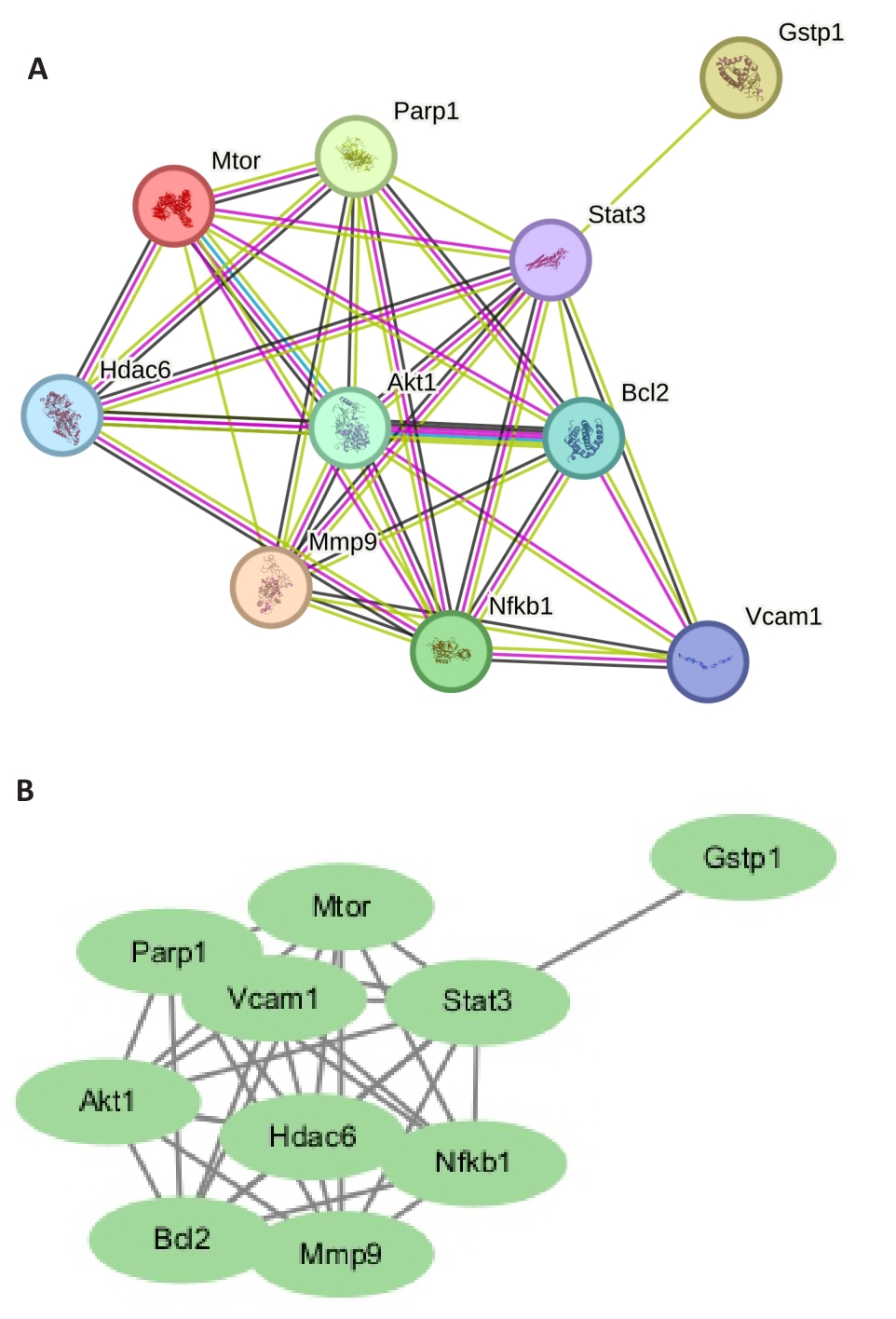
Fig.2 Core protein-protein interaction (PPI) network. A: Visual regulatory network of plumbagin-sepsis myocardial injury-pyroptosis. B: PPI network of plumbagin-sepsis myocardial injury-pyroptosis related targets.
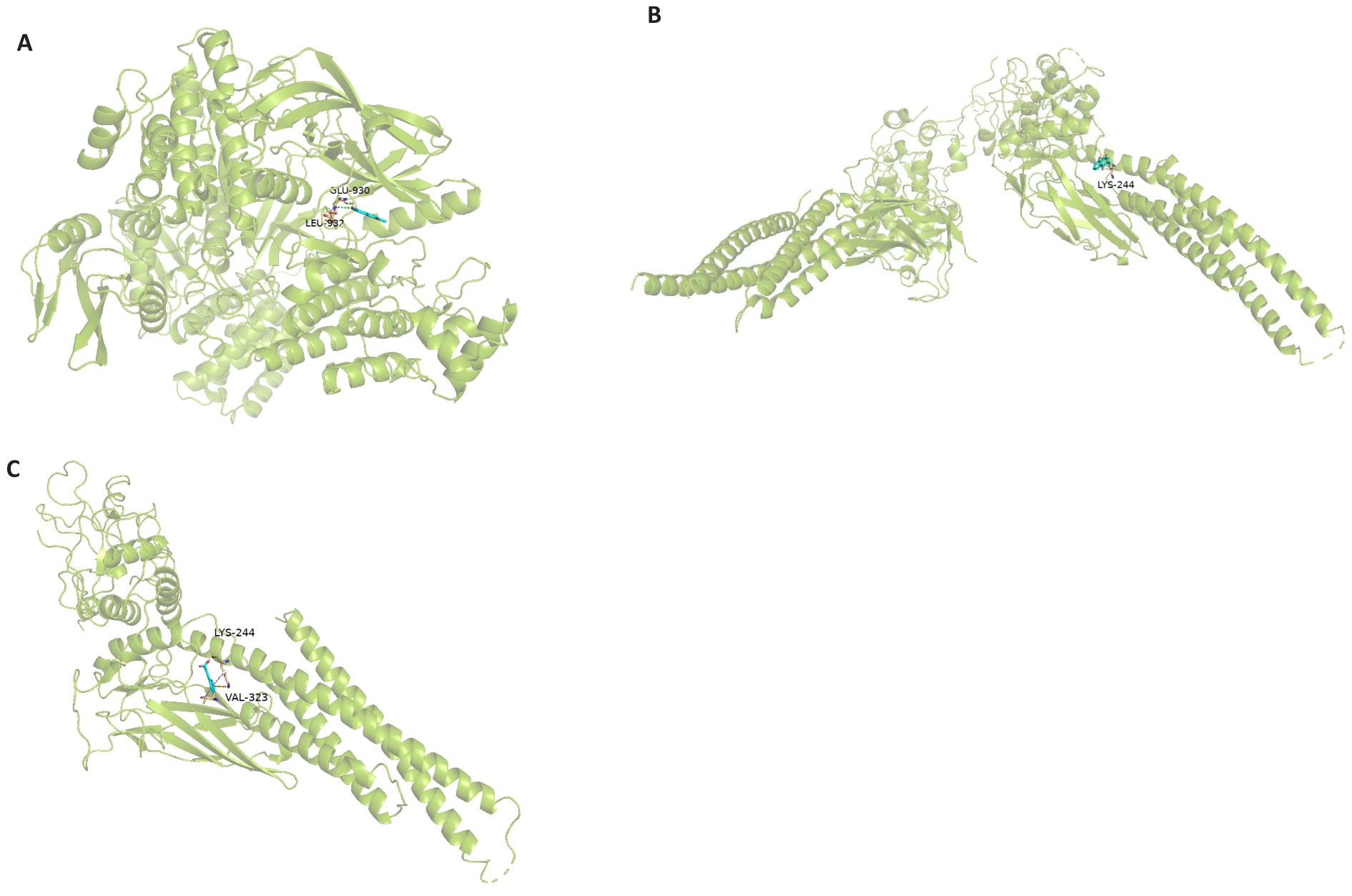
Fig.5 Molecular docking results. A: Molecular docking diagram of plumbagin and STAT3. B: Molecular docking diagram of plumbagin and JAK2. C: Molecular docking diagram of plumbagin and p-STAT3.
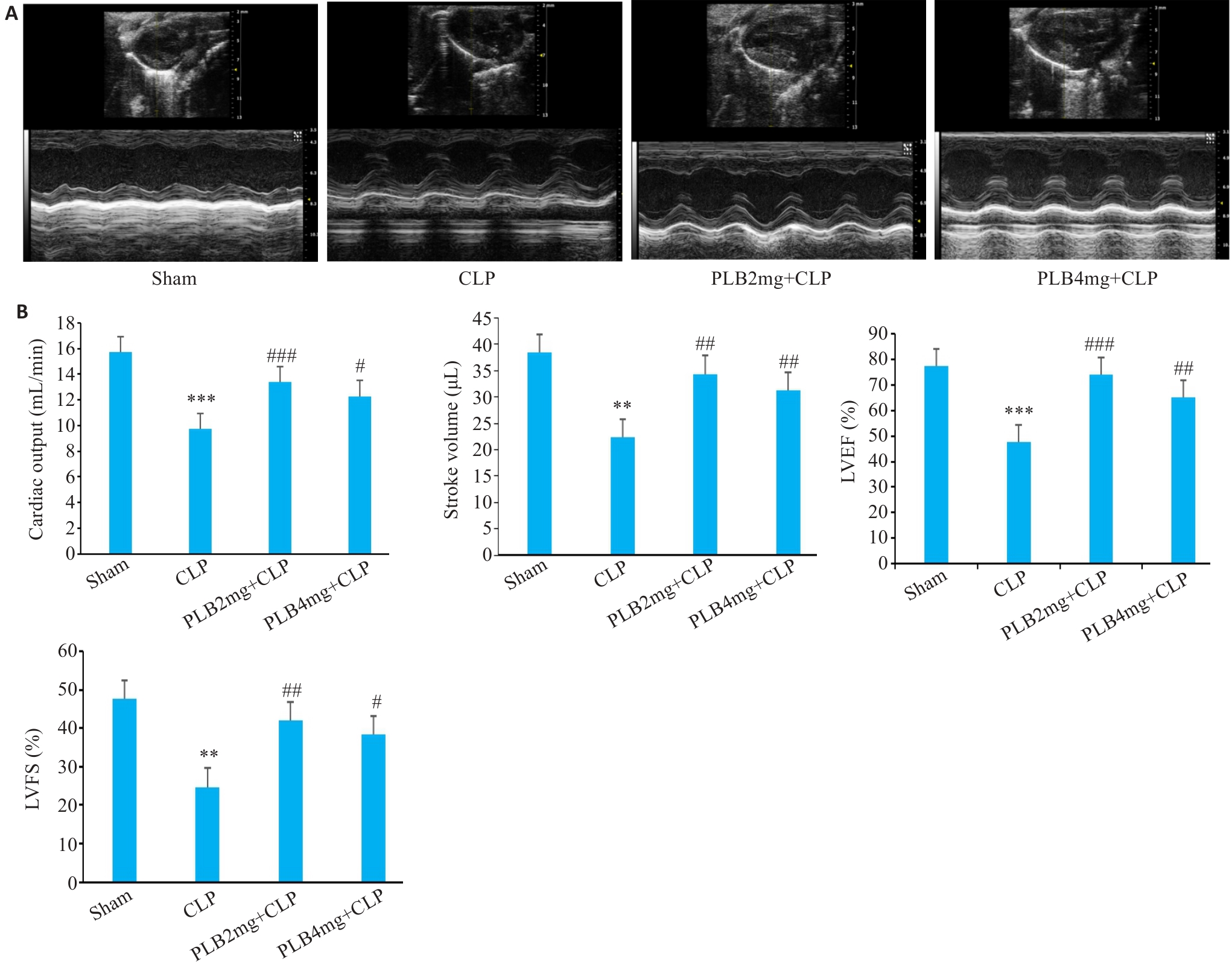
Fig.6 Cardiac ultrasound images and cardiac function indexes of the mice in different groups (Mean±SD, n=6). A: Evaluation of cardiac function by M-mode echocardiography. B: Comparison of the echocardiographic parameters (LVEF: Left ventricle ejection fraction; LVFS: Left ventricular fractional shortening). **P<0.01, ***P<0.001 vs Sham group, #P<0.05, ##P<0.01, ###P<0.001 vs CLP group.
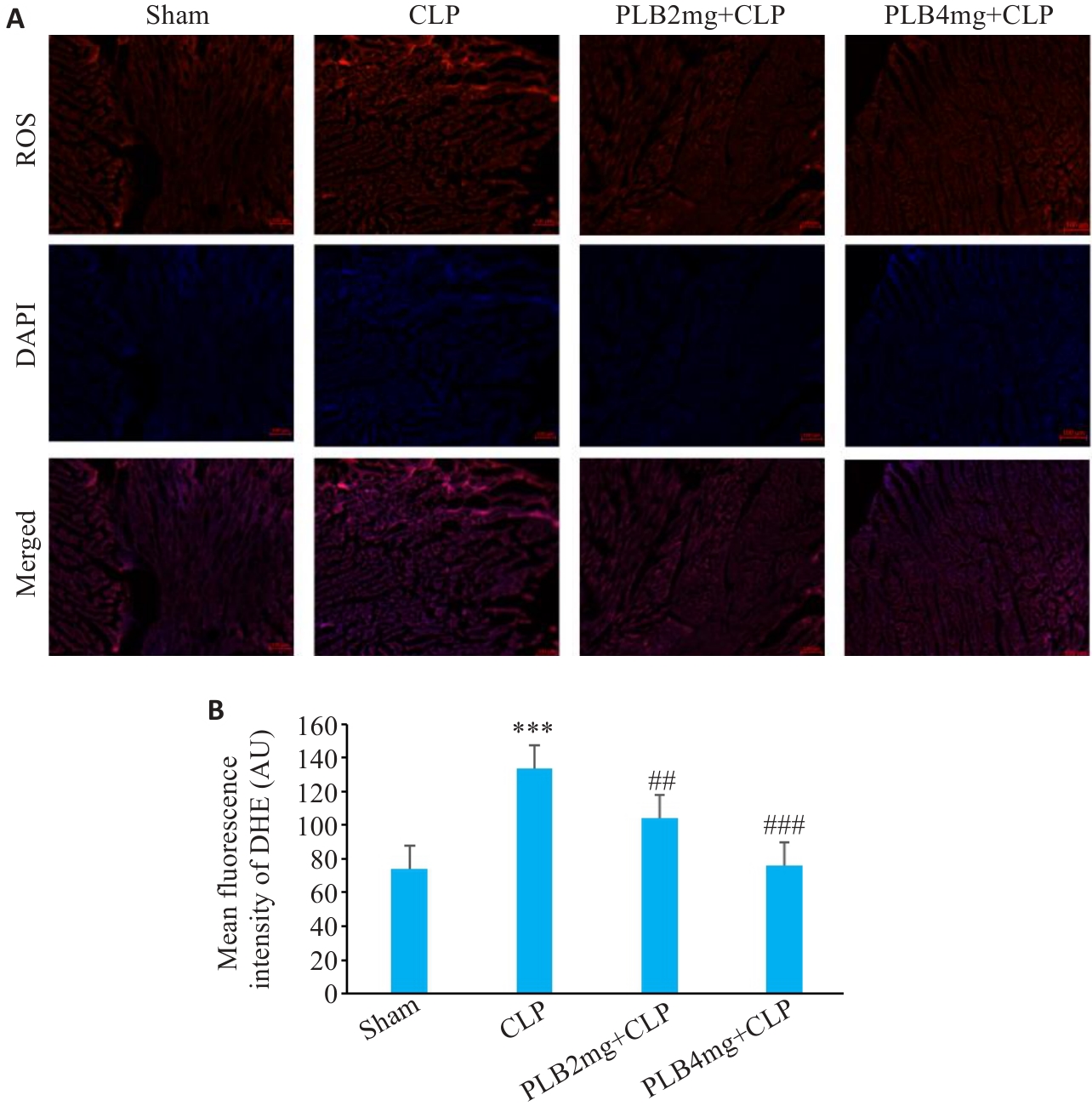
Fig.8 DHE fluorescence staining of myocardial fibers in different groups. A: Fluorescence probe for ROS in the cardiac tissues (Original magnification: ×200). B: ROS fluorescence intensity in each group (Mean±SD, n=6). ***P<0.001 vs sham group; ##P<0.01, ###P<0.001 vs the CLP group.

Fig.9 Serum IL-18 (A) and IL-1β (B) levels in the myocardial tissue in different groups (Mean±SD, n=6). ***P<0.001 vs sham group; #P<0.05 vs CLP group.

Fig.10 Serum MDA (A), CK-MB (B) and LDH (C) levels in the myocardial tissue in different groups (Mean±SD, n=6). ***P<0.001 vs sham group; #P<0.05, ##P<0.01 ###P<0.001 vs CLP group.
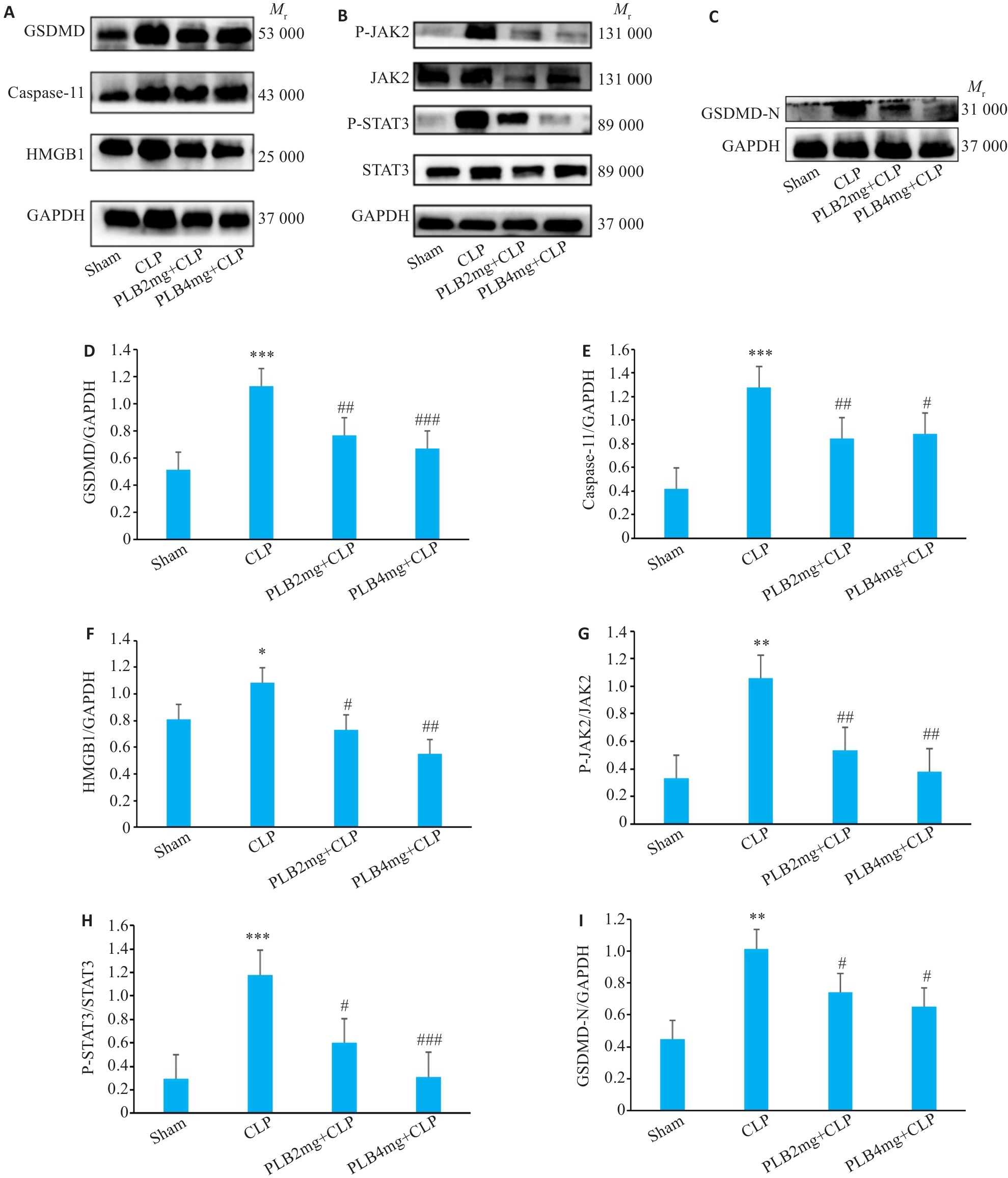
Fig.11 Comparison of GSDMD、Caspase-11、HMGB1、P-JAK2、JAK2、P-STAT3、STAT3 and GSDMD-N protein levels in the myocardial tissues among the 4 groups. A-C: Protein bands in Western blotting. D-I: Relative protein levels of GSDMD、Caspase-11、HMGB1、P-JAK2、JAK2、P-STAT3、STAT3 and GSDMD-N proteins (Mean±SD, n=3). *P<0.05, **P<0.01, ***P<0.001 vs sham group; #P<0.05, ##P<0.01, ###P<0.001 vs CLP group.
| 1 | Shankar-Hari M, Phillips GS, Levy ML, et al. Developing a new definition and assessing new clinical criteria for septic shock: for the third international consensus definitions for sepsis and septic shock (sepsis-3)[J]. JAMA, 2016, 315(8): 775-87. |
| 2 | Li Z, Wu BQ, Chen J, et al. WWP2 protects against sepsis-induced cardiac injury through inhibiting cardiomyocyte ferroptosis[J]. J Transl Int Med, 2024, 12(1): 35-50. |
| 3 | Zhao XJ, Xie JG, Duan CJ, et al. ADAR1 protects pulmonary macrophages from sepsis-induced pyroptosis and lung injury through miR-21/A20 signaling[J]. Int J Biol Sci, 2024, 20(2): 464-85. |
| 4 | Liu ZJ, Wei JH, Sun HB, et al. Plumbagin ameliorates LPS-induced acute lung injury by regulating PI3K/AKT/mTOR and Keap1-Nrf2/HO-1 signalling pathways[J]. J Cell Mol Med, 2024, 28(13): e18386. |
| 5 | Zhang QR, Fu HT, Gong WJ, et al. Plumbagin protects H9c2 cardiomyocytes against TBHP-induced cytotoxicity by alleviating ROS-induced apoptosis and modulating autophagy[J]. Exp Ther Med, 2022, 24(2): 501. |
| 6 | Li Z, Chinnathambi A, Ali Alharbi S, et al. Plumbagin protects the myocardial damage by modulating the cardiac biomarkers, antioxidants, and apoptosis signaling in the doxorubicin-induced cardiotoxicity in rats[J]. Environ Toxicol, 2020, 35(12): 1374-85. |
| 7 | Petrocelli G, Marrazzo P, Bonsi L, et al. Plumbagin, a natural compound with several biological effects and anti-inflammatory properties[J]. Life, 2023, 13(6): 1303. |
| 8 | Wang SX, Wang J, Shao JB, et al. Plumbagin mediates cardioprotection against myocardial ischemia/reperfusion injury through nrf-2 signaling[J]. Med Sci Monit, 2016, 22: 1250-7. |
| 9 | Zhao L, Zhang H, Li N, et al. Network pharmacology, a promising approach to reveal the pharmacology mechanism of Chinese medicine formula[J]. J Ethnopharmacol, 2023, 309: 116306. |
| 10 | Zhang ZX, Deng WJ, Kang R, et al. Plumbagin protects mice from lethal sepsis by modulating immunometabolism upstream of PKM2[J]. Mol Med, 2016, 22: 162-72. |
| 11 | Huang YH, Li L, Li YP, et al. Knockdown of LncRNA Lcn2-204 alleviates sepsis-induced myocardial injury by regulation of iron overload and ferroptosis[J]. J Mol Cell Cardiol, 2024, 192: 79-93. |
| 12 | Wang J, Wang XT, Liu DW, et al. Induction and deduction in sepsis-induced cardiomyopathy: five typical categories[J]. Chin Med J, 2020, 133(18): 2205-11. |
| 13 | Kumar Arora M, Ratra A, Asdaq SMB, et al. Plumbagin alleviates intracerebroventricular-quinolinic acid induced depression-like behavior and memory deficits in wistar rats[J]. Molecules, 2022, 27(6): 1834. |
| 14 | Guo YX, Liu L, Yan DZ, et al. Plumbagin prevents osteoarthritis in human chondrocytes through Nrf-2 activation[J]. Mol Med Rep, 2017, 15(4): 2333-8. |
| 15 | Monnet X, Lai C, Teboul JL. How I personalize fluid therapy in septic shock[J]? Crit Care,2023,27(1):123. |
| 16 | Vigneron C, Py BF, Monneret G, et al. The double sides of NLRP3 inflammasome activation in sepsis[J]. Clin Sci, 2023, 137(5): 333-51. |
| 17 | Yang R, Zhang XJ. A potential new pathway for heparin treatment of sepsis-induced lung injury: inhibition of pulmonary endothelial cell pyroptosis by blocking hMGB1-LPS-induced caspase-11 activation[J]. Front Cell Infect Microbiol, 2022, 12: 984835. |
| 18 | Sheng SY, Li JM, Hu XY, et al. Regulated cell death pathways in cardiomyopathy[J]. Acta Pharmacol Sin, 2023, 44(8): 1521-35. |
| 19 | Wu ZF, Deng JH, Zhou HW, et al. Programmed cell death in sepsis associated acute kidney injury[J]. Front Med, 2022, 9: 883028. |
| 20 | Cao ZZ, Qin HQ, Huang YH, et al. Crosstalk of pyroptosis, ferroptosis, and mitochondrial aldehyde dehydrogenase 2-related mechanisms in sepsis-induced lung injury in a mouse model[J]. Bioengineered, 2022, 13(3): 4810-20. |
| 21 | Zangiabadi S, Abdul-Sater AA. Regulation of the NLRP3 inflammasome by posttranslational modifications[J]. J Immunol, 2022, 208(2): 286-92. |
| 22 | Jia YJ, Xiong S, Yao M, et al. HMGB1 inhibition blocks ferroptosis and oxidative stress to ameliorate sepsis-induced acute lung injury by activating the Nrf2 pathway[J]. Kaohsiung J Med Sci, 2024, 40(8): 710-21. |
| 23 | 梁 欢, 黄毓慧, 高 琴.非经典途径细胞焦亡在脓毒症等炎症性疾病中的作用[J].中南大学学报(医学版), 2021, 46(11): 1276-84. |
| 24 | Li X, Wei SZ, Niu SQ, et al. Network pharmacology prediction and molecular docking-based strategy to explore the potential mechanism of Huanglian Jiedu Decoction against sepsis[J]. Comput Biol Med, 2022, 144: 105389. |
| 25 | Yuan ZZ, Pan YY, Leng T, et al. Progress and prospects of research ideas and methods in the network pharmacology of traditional Chinese medicine[J]. J Pharm Pharm Sci, 2022, 25: 218-26. |
| 26 | Li YR, Jia YJ, Cui TF, et al. IL-6/STAT3 signaling pathway regulates the proliferation and damage of intestinal epithelial cells in patients with ulcerative colitis via H3K27ac[J]. Exp Ther Med, 2021, 22(2): 890. |
| 27 | Foers AD, Garnham AL, Chatfield S, et al. Extracellular vesicles in synovial fluid from rheumatoid arthritis patients contain miRNAs with capacity to modulate inflammation[J]. Int J Mol Sci, 2021, 22(9): 4910. |
| 28 | Wang C, Liu N, Yang HT. Desflurane pretreatment can reduce sepsis-evoked lung injury in rats via inhibiting STAT3 pathway[J]. J Biol Regul Homeost Agents, 2020, 34(3): 935-42. |
| 29 | Jiang T, Peng DW, Shi W, et al. IL-6/STAT3 signaling promotes cardiac dysfunction by upregulating FUNDC1-dependent mitochondria-associated endoplasmic reticulum membranes formation in sepsis mice[J]. Front Cardiovasc Med, 2022, 8: 790612. |
| 30 | Li RQ, Li XQ, Zhao J, et al. Mitochondrial STAT3 exacerbates LPS-induced sepsis by driving CPT1a-mediated fatty acid oxidation[J]. Theranostics, 2022, 12(2): 976-98. |
| 31 | Shen YN, Zhang Y, Du JY, et al. CXCR5 down-regulation alleviates cognitive dysfunction in a mouse model of sepsis-associated encephalopathy: potential role of microglial autophagy and the p38MAPK/NF‑κB/STAT3 signaling pathway[J]. J Neuroinfl-ammation, 2021, 18(1): 246. |
| 32 | Xie LP, Wu YT, Zhou CY, et al. Piceatannol protects against sepsis-induced myocardial dysfunction via direct inhibition of JAK2[J]. Int Immunopharmacol, 2021, 96: 107639. |
| 33 | Zhen GS, Liang W, Jia HM, et al. Melatonin relieves sepsis-induced myocardial injury via regulating JAK2/STAT3 signaling pathway[J]. Minerva Med, 2022, 113(6): 983-9. |
| 34 | 孙 永, 史兆博, 刘美香, 等. 山药多糖对脓毒症大鼠心肌损伤及JAK2/STAT3信号通路的影响[J]. 中国动脉硬化杂志, 2022, 30(8): 669-75. |
| 35 | Jiang JX, Zhang D, Liu W, et al. Overexpression of NLRP12 enhances macrophage immune response and alleviates herpes simplex keratitis[J]. Front Cell Infect Microbiol, 2024, 14: 1416105. |
| [1] | Xingmei CHEN, Qinwen LIU, Yi LI, Xiaoyu ZHONG, Qiling FAN, Ke MA, Liuting LUO, Daogang GUAN, Zhibo ZHU. Analysis of core functional components in Yinchenhao Decoction and their pathways for treating liver fibrosis [J]. Journal of Southern Medical University, 2024, 44(8): 1508-1517. |
| [2] | Shanyuan ZHANG, Qiaoyan CAI, Jianghan QI, Kaixin YIN, Chenchen HE, Zhuye GAO, Ling ZHANG, Jianfeng CHU. Pharmacodynamics of Qingxin Jieyu Granules for treatment of atherosclerosis and its regulatory mechanism for lipid metabolism [J]. Journal of Southern Medical University, 2024, 44(8): 1518-1528. |
| [3] | Yuming ZHANG, Shicheng XIA, Linlin ZHANG, Mengxi CHEN, Xiaojing LIU, Qin GAO, Hongwei YE. Protective effect of Lonicerae japonicae flos extract against doxorubicin-induced liver injury in mice [J]. Journal of Southern Medical University, 2024, 44(8): 1571-1581. |
| [4] | Jinjin WANG, Wenfei CUI, Xuewei DOU, Binglei YIN, Yuqi NIU, Ling NIU, Guoli YAN. Euonymus alatus delays progression of diabetic kidney disease in mice by regulating EGFR tyrosine kinase inhibitor resistance signaling pathway [J]. Journal of Southern Medical University, 2024, 44(7): 1243-1255. |
| [5] | Linyue WANG, Wenyue QI, Jihua GAO, Maosheng TIAN, Jiancheng XU. Tongyangxiao Lotion promotes postoperative wound healing in a rat model of anal fistula by downregulating inflammatory factors and suppressing inflammation [J]. Journal of Southern Medical University, 2024, 44(7): 1256-1265. |
| [6] | Wenxiang ZHANG, Huixian GU, Pengde CHEN, Siyu WU, Hongyan MA, Lan YAO. Compound Yuye Decoction protects diabetic rats against cardiomyopathy by inhibiting myocardial apoptosis and inflammation via regulating the PI3K/Akt signaling pathway [J]. Journal of Southern Medical University, 2024, 44(7): 1306-1314. |
| [7] | Yan HUANG, Lulu QIN, Shaoxing GUAN, Yanping GUANG, Yuru WEI, Ailing CAO, Dongmei LI, Guining WEI, Qibiao SU. Therapeutic mechanism of aqueous extract of Semiliquidambar cathayensis Chang root for pancreatic cancer: the active components, therapeutic targets and pathways [J]. Journal of Southern Medical University, 2024, 44(7): 1336-1344. |
| [8] | Zhijun REN, Jianxin DIAO, Yiting WANG. Xionggui Decoction alleviates heart failure in mice with myocardial infarction by inhibiting oxidative stress-induced cardiomyocyte apoptosis [J]. Journal of Southern Medical University, 2024, 44(7): 1416-1424. |
| [9] | Ruibo LI, Ge GAO, Xi XIE, Haibin LUO. Oral submucosal fibrosis induced by active components in areca nut: a network pharmacology-based analysis and validation of the mechanism [J]. Journal of Southern Medical University, 2024, 44(5): 930-940. |
| [10] | Yiming SUN, Rong ZHANG, Ying MENG, Lei ZHU, Mingqiang LI, Zhe LIU. Coenzyme Q10 alleviates depression-like behaviors in mice with chronic restraint stress by down-regulating the pyroptosis signaling pathway [J]. Journal of Southern Medical University, 2024, 44(5): 810-817. |
| [11] | LI Yunfei, YANG Jingyi, ZHANG Ying, ZHANG Caixia, WEI Yuxiang, WANG Yiying, WU Ning, SUN Jianfei, WU Zunqiu. The Miao medicine Sidaxue alleviates rheumatoid arthritis in rats possibly by downregulating matrix metalloproteinases [J]. Journal of Southern Medical University, 2024, 44(4): 739-747. |
| [12] | CHEN Junjie, HUANG Chuanbing, LI Ming. Jianpi Zishen granule inhibits podocyte autophagy in systemic lupus erythematosus: a network pharmacology and clinical study [J]. Journal of Southern Medical University, 2024, 44(3): 465-473. |
| [13] | CUI Yixin, WANG Decai, XIE Dongqing, WANG Haiming, XU Ruixin, TANG Xiaoran, ZHANG Yin. Efficacy of navel application of Jianpiwenyang Gel for chronic diarrhea of spleen and stomach weakness type: a randomized controlled trial and analysis of the mechanism [J]. Journal of Southern Medical University, 2024, 44(2): 217-225. |
| [14] | FANG Shangping, SUN Renke, SU Hui, ZHAI Kecheng, XIANG Yu, GAO Yangmengna, GUO Wenjun. Chlorogenic acid alleviates acute kidney injury in septic mice by inhibiting NLRP3 inflammasomes and the caspase-1 canonical pyroptosis pathway [J]. Journal of Southern Medical University, 2024, 44(2): 317-323. |
| [15] | Duanyi SONG, Yun LI, Xuefang TANG, Hua LI, Kang TAO. Diazepam alleviates pulmonary fibrosis in mice by inhibiting LPS-induced pyroptosis and inflammation via the let-7a-5p/MYD88 axis [J]. Journal of Southern Medical University, 2024, 44(11): 2092-2101. |
| Viewed | ||||||
|
Full text |
|
|||||
|
Abstract |
|
|||||